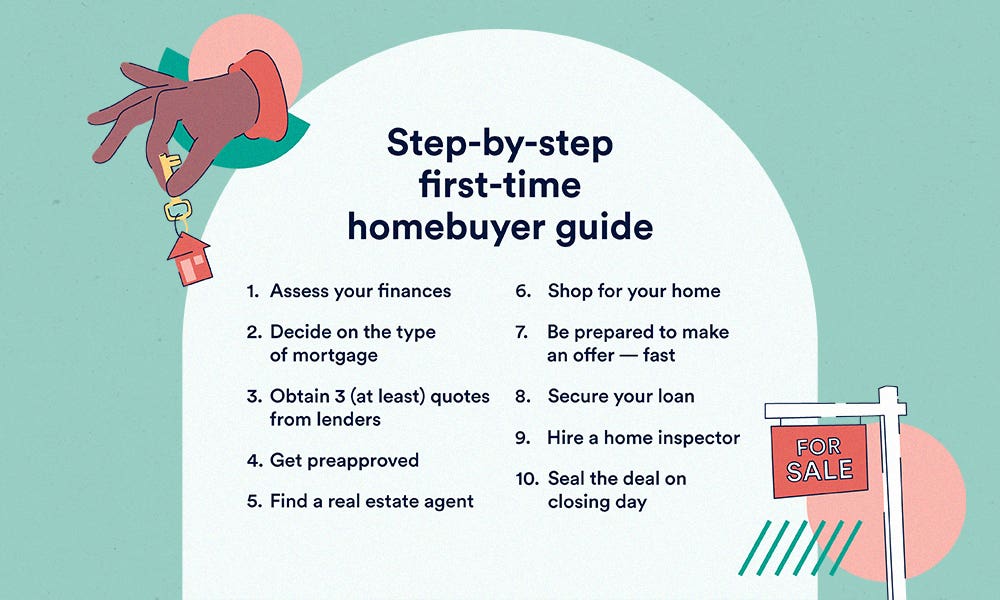First-time homebuyer guide

The Bankrate promise
At Bankrate we strive to help you make smarter financial decisions. While we adhere to strict , this post may contain references to products from our partners. Here's an explanation for .
Key takeaways
- A first-time homebuyer is someone who has either never owned a home or who has not owned a home in the last several years.
- First-time homebuyer programs offer loans with low down payments and favorable terms.
- Buying a new house involves many steps, from securing financing to negotiating with sellers. A reputable real estate agent is a valuable resource and can help you navigate the process.
- Homeowners should regularly assess their mortgage as economic conditions change, and budget for maintenance and repairs.
So, you’re in the market to buy a new home. Whether it’s your first time seeking homeownership or you’ve been through it before but forgotten the details, this first-time homebuyer guide provides some handy tips to prepare you for what’s ahead.
What is a first-time homebuyer?
A first-time homebuyer often refers to someone who has never purchased a residence before (obviously). But in some contexts, the definition is actually much broader, referring to someone who simply has not owned a home for at least the previous three years. That’s how it’s often defined by a variety of first-time homebuyer grants and loan programs. The IRS, for some tax purposes, qualifies someone who hasn’t owned a home in two years as a first-timer.
Benefits of being a first-time homebuyer
Being a novice often feels like a nuisance. However, there are actually perks to being a first-time homebuyer.
The main one is first-time homebuyer programs, which are designed to make purchasing a home more affordable. Some lenders offer a mix of slightly discounted mortgage rates, minimal fees and low or no down payment options for qualifying novices. Many states and local governments have programs that offer down payment or closing cost assistance — either low-interest-rate loans, deferred loans or even forgivable loans (aka grants) — to people looking to buy their first house (even if it isn’t actually their first purchase).
Many programs count you as a first-timer if you or your spouse hasn’t owned a home in the past three years. However, some of these programs have other requirements, such as income limits or purchase price maximums. Check out the housing authority in your local state or municipality for first-time homebuyer opportunities you might be eligible for.
In certain states, first-time homebuyers might also qualify for a mortgage credit certificate (MCC), essentially a dollar-for-dollar federal tax refund of a percentage of their annual loan interest.
Challenges of being a first-time homebuyer
All of that said, buying a new house can come with challenges. Be ready to:
- Have lots of liquidity — While people who already own a home can use the proceeds from selling their existing place to cover their down payment and closing costs, figuring out how to buy a house for the first time requires you to have a chunk of cash on hand. Down payments these days easily run into the five figures. Closing costs can run into the thousands, too — as much as 6 percent of your mortgage.
- Prepare the paperwork — If you’re financing your home purchase, you’ll have to provide your lender with lots of financial documentation. The underwriters can’t discriminate against you for being a novice, but they might look at you harder since you probably have less of a credit history. And you might need to provide some extra information. For example, if relatives are generously donating money toward the down payment, they’ll need to document it in a gift letter.
- Pay for ongoing costs — Paying for home maintenance costs is one of the biggest transitions from renting to owning, so make sure you budget accordingly. Also be prepared for other ongoing expenses that are part of the joys of homeownership, like property taxes, homeowners insurance and HOA fees. These are required by law or by your lender.
- Manage the stress — Buying a new house and moving into it is one of the biggest stressors in life. Don’t be surprised if it takes over your life. There’s a fair amount of hurry up and wait, too, like waiting for a response to your offer and waiting for the bank to approve your mortgage. It all gets extra anxiety-inducing when you don’t know how the process typically goes — which is why the next section lays out a step-by-step guide for first-time homebuyers.
Step-by-step first-time homebuyer guide
Here’s a rundown of the typical stages that you go through in a home purchase. Keep in mind there are always individual twists and turns on the driveway to your dream house.

Step 1: Assess your finances
A home is the biggest single item most people ever purchase. You’ll have to get a loan if you can’t pay cash, so it’s important to ensure your finances are in a good position to handle a mortgage.
Start by checking your credit report and score, examining your budget and assessing your ability to make a down payment and pay closing costs.
Credit
With a higher credit score, you can get favorable loan terms that will save you money over the life of your mortgage. That said, you can still get a loan with a score as low as 500 (for an FHA loan) or 620 (for a conventional loan), but you may not get the most attractive rate. A score of 760 or higher is the sweet spot for the best terms.
Debt-to-income ratio
Look at how much in regular outgoing expenses you have relative to your incoming funds, or your debt-to-income (DTI) ratio.
The ideal spend for housing costs — including the mortgage payment, property taxes, homeowners insurance and homeowners association dues — is 28 percent of your gross monthly income. For all of your monthly debt payments, including housing costs, the ideal spend is 36 percent.
Many mortgage lenders look for a maximum 43 percent DTI ratio, but some go higher — up to 50 percent. The higher your DTI ratio, however, the more likely you are to pay a higher interest rate for your mortgage because you’re considered a riskier borrower. A higher DTI ratio can also make managing your mortgage payments a bigger strain on your finances.
Down payment
If you’re interested in a conventional loan and can put 20 percent down, you’ll avoid paying private mortgage insurance (PMI). This is an extra monthly fee that covers the lender should you default on the loan.
You don’t have to put down 20 percent, though — you can pay as little as 3 percent, depending on the type of conventional loan you get, with PMI. If you’re getting a VA loan or a USDA loan, you don’t have to make any down payment. FHA loans, meanwhile, require a minimum of 3.5 percent down.
Savings
Closing costs can range from 2 to 5 percent of the home’s purchase price. Depending on lender fees, you could pay a significant sum on closing day, so you’ll need to have these funds set aside.
There’s also the earnest money deposit, which is a smaller deposit submitted with your initial offer to buy a home. This cost varies but is usually 1 percent of the home’s purchase price.
Don’t forget: You’ll also want some savings lined up for moving expenses and furniture, or possible repairs or updates you’d like to make to the home.
Step 2: Decide which type of mortgage to get
There are many types of mortgages. Your first consideration is whether you want a fixed-rate or adjustable-rate mortgage (ARM).
Fixed or adjustable rate
Fixed-rate loans tend to have slightly higher rates, but the rate — and your monthly payment — never changes. An ARM typically starts with a lower rate for a set time (such as five or seven years) and then adjusts up or down at a predetermined interval (such as once a year). If the rate goes up, your monthly payment will increase with it.
Fixed-rate loans offer more stability for those who plan to stay in one place. That said, if you don’t plan to live in a home for a long time, an adjustable-rate mortgage can potentially save you some money.
Loan terms
Also consider your loan term, such as 15 or 30 years. Shorter-term loans have lower rates, but larger monthly payments. This means less flexibility in your budget each month in exchange for lower borrowing costs. It’s up to you whether a lower monthly cost or overall savings is more important. Most first-time homebuyers get a 30-year, fixed-rate mortgage.
Step 3: Get quotes from at least three mortgage lenders
Comparing mortgage loan offers is one of the essential steps to buying a house. Aim to get rate quotes from at least three lenders, as mortgage interest rates vary considerably and change often.
You don’t need to apply for a loan to get an offer. Often, you can get a free quote through the lender’s website if you provide basic information, like your desired loan amount, your down payment and your credit score range. In general, you’ll want to pay the lowest interest rate. But do weigh all the fees that come with a loan — sometimes a loan with a lower rate actually ends up having a higher annual percentage rate (APR).
If you’re a first-time homebuyer, you might also want to get a sense of how rates fluctuate and the current rate environment so you know what to expect when you seek a quote. You can sign up for a Bankrate account to determine the right time to strike on your mortgage with our daily rate trends.
Step 4: Get preapproved for a mortgage
The next step in this first-time homebuyer guide is to get preapproved for a mortgage. A preapproval is a written, preliminary commitment from a lender to loan you a certain amount of money. It is not a finalized offer. The preapproval letter typically spells out how much you’re qualified to borrow, what loan program you’re using and the expected down payment you can make.
Getting preapproved is necessary before starting your home search because sellers generally won’t consider your offer unless they know you have the financing lined up.
When you request a preapproval, be prepared for your mortgage lender to dig into all aspects of your financial life. Gather your pay stubs and bank statements from at least the past two months, your W-2 forms and federal tax returns from the past two years and any other information on other assets and debt you have.
Be sure you’re actually getting a preapproval, not a prequalification. A prequalification could indicate that you might be approved for a mortgage but is better used to help you determine how much you might be able to afford.
Step 5: Find a real estate agent
Now, it’s time to loop in someone who can work alongside you during this process. A real estate agent knows the area and the local housing market well and can provide valuable insights about neighborhoods, school districts and more.
You can start your search by asking around for recommendations for a buyer’s agent. You can also research online for highly-rated agents and review testimonials from past clients.
Aim to interview at least three buyer’s agents. Ask them about their experience and track record, and whether they specialize in any particular type of residence, such as condos. Ask for references, as well.
In today’s market, you could be competing against many offers, so you’ll also want an agent who’ll be able to move quickly on a home you’re interested in and help you navigate a bidding war, if that happens. Talk to your agent about their communication style and how they’ve helped guide other buyers through the current market.
Step 6: Shop for your home
This is the fun part of this home-buying guide. Talk to your agent about your budget and top requirements so that you don’t waste time looking at homes that don’t meet your needs. If possible, visit homes in person, and avoid buying a home sight unseen, even if it seems like the perfect fit based on an online description and photos.
During showings, tour the home and the neighborhood. The location is often just as important as the home itself.
For a home in a homeowners association, get a copy of the HOA documents so you know what the rules and fees are, too.
Step 7: Be prepared to make an offer — fast
If you tour a home you love, be ready to make an offer fast. Your agent can analyze comparable listings (“comps”) that have recently sold in the area to help you make a competitive offer.
The offer should include an offer price, a deadline for the seller to respond (usually within 24 to 48 hours) and any contingencies you want to request. At a minimum, the offer should include appraisal and home inspection contingencies. That means that if the home appraises under the offer price or an inspection reveals significant issues, you can walk away without losing your deposit. If a bidding war seems likely, the offer should also include an escalation clause with your top offer limit.
While some buyers waive contingencies to get their offer accepted, avoid doing this if possible. You won’t want to buy a home and later find out it has issues way beyond what your budget can accommodate to repair. However, some very hot markets make it hard to buy a home with certain contingencies. In this case, speak with your Realtor about what’s realistic.
Get ready to negotiate on price
Once your Realtor presents the seller with a purchase agreement, the seller can accept, reject or counter with a different price. Tap your agent’s experience to negotiate with the seller for the best possible outcome on your first home purchase. It’s not uncommon for homes to sell quickly and above the list price. So, don’t panic if you don’t get the first home you place an offer on.
Step 8: Secure your mortgage
If the seller accepts your offer, it’s time to apply for your mortgage. This can be one of the most rigorous steps to buying a house.
Within three days of applying, you’ll get a loan estimate that details the loan terms and estimated closing costs, along with other information. Some closing costs are negotiable; your lender might charge an origination and underwriting fee that could be waived or discounted if you ask, or offer a no-closing-cost option that rolls these fees into your loan. (You’ll typically pay a higher interest rate to go this route, however.) Ask your lender to clarify any fees you don’t understand.
If you need help with closing costs, you could look to your state’s housing finance agency. Local housing organizations also offer down payment and closing cost assistance programs.
Paying for mortgage points
Another consideration to make is whether you should pay for mortgage points to reduce your mortgage rate. Effectively, by paying points, you’re prepaying some of the interest on your loan. Generally, each point costs 1 percent of the total value of your loan, so buying one point on a $350,000 mortgage will cost $3,500. Each point you pay usually reduces the rate by 0.25 percent.
In general, the longer you plan to stay in a home, the more sensible it is to buy points as you’ll recoup the cost by way of the lower monthly payment on your loan. To calculate the breakeven point, divide the amount you pay for a point by the amount you’ll reduce your mortgage payment by each month.
Step 9: Hire a home inspector
After your offer is accepted, hire a home inspector to evaluate the property. Your agent can recommend a home inspector, or you can locate one through the American Society of Home Inspectors, the International Association of Certified Home Inspectors and the National Academy of Building Inspection Engineers. As you did when researching agents, consult online resources to check for complaints and read testimonials.
An inspector will check the home’s foundation, roof, HVAC, plumbing and electrical systems, but typically won’t check for the presence of lead paint or mold. The inspection can take about two or three hours and range from $300 to $1,000, depending on the home’s size and the extent of the inspection. You and your agent should be present during the inspection so you can ask for clarification on any issues.
If the inspection report uncovers major problems, you could try to ask the seller to fix them, but the seller might not be willing to if there are other offers that won’t require them to pay for repairs. If you have an inspection contingency in your purchase agreement and the seller is unwilling to address the issues, you might choose to walk away instead.
Step 10: Get homeowners insurance, finalize your move and (finally!) close
You’ve made it to the home stretch of your new home acquisition — congrats! There are just a few more hurdles to jump.
Insure the house
For starters, mortgage lenders require homeowners insurance, which helps protect your (and their) investment. Insurance premiums vary, so get quotes from several companies or work with an insurance broker who can shop rates for you. Assess your needs and ensure you buy adequate coverage to completely rebuild your home if it’s destroyed or seriously damaged. If your home is located in a federally designated flood zone, you’ll need to buy flood insurance, too.
Plan your move
Depending on how quickly you plan to move, you’ll likely want to start planning for the move before the closing. As you prepare for move-in day, contact your utility, cable and internet providers to arrange new service for your move-in date. Then hire a reputable mover and start packing.
Go to your closing
Finally, it’s time to put pen to paper and close on your new house. The closing is when you finalize the purchase contract and officially become a homeowner.
Just before the closing, get updated pay stubs and other financial paperwork to prove your employment status hasn’t changed and that you’ll be able to make your mortgage payments. If you’re paying closing costs on closing day, obtain a cashier’s or certified check made out to the escrow company for the funds ahead of time. Don’t forget to bring a photo ID, too.
Within 24 hours of closing, you’ll do a final walkthrough of the property to make sure repairs, if any, were made and that the home is vacant. At the closing table, you’ll sign a lot of paperwork to finalize the loan and transfer ownership of the home from the seller’s name to yours.
What’s next for homeowners with a new house
Buying a home can be a long process — especially as a first-time homebuyer — but once you move in, there’s still some work to do.
First, assess your home and think about what you might want to change or fix. If you haven’t already, start building a home improvement fund for these projects, and set aside separate funds to cover unexpected repairs, too.
As time goes on, keep an eye on the housing market, and especially mortgage rates. If home values are rising, you might consider tapping your home’s equity in a cash-out refinance or with a home equity line of credit (HELOC) or home equity loan. If interest rates have fallen, refinancing to a lower rate could save you money. Of course, weigh the pros and cons of each of these options. Even in a lower-rate environment, the math on a refinance doesn’t always work out positively.
Depending on your loan terms and how your finances change, you might also want to reevaluate your mortgage payment schedule and explore making extra payments or paying off your mortgage early. Consider your goals and whether there are other financial moves you could make before focusing on a payoff. If you do decide to prepay, talk to your lender beforehand to ensure the extra payments will go to the loan principal, not interest, and you won’t come up against any early payment fees.
FAQ
-
This guide for first-time homebuyers probably left you wondering about some key details. Never be afraid to ask the pros.
When it comes to your home loan, ask your mortgage lender to clearly explain the terms of the loan. You might ask them to walk through your loan estimate with you. Ask about the likelihood of your interest rate changing before closing, and if there’s a charge to extend your rate lock.
When it comes to the home, you should also ask your real estate agent for their opinion on the house and neighborhood you’re considering — and how much negotiation they think the seller might be open to.
When it comes to the purchase and sale agreement, nail down what fixtures there are — features and furnishings that are included with the house. You might also ask your Realtor or a real estate attorney what contingencies your contract should include — grounds for canceling the sale, should something not work out, for example.
-
Generally, aim to stick with the 28/36 rule when buying a new house. That means not more than 28 percent of your gross monthly income should go to your mortgage. And with the mortgage in play, 36 percent of your gross monthly income or less should go to your overall debt.
Managing your debt and ensuring your finances can handle your mortgage get extra important as a first-time homebuyer, so do your due diligence here.
-
As a homebuyer, you can expect closing costs of up to 5 percent of the loan amount. They cover the fees for the appraisal, title search, title insurance, loan origination, attorney and loan underwriting. You may also incur home inspection fees if you choose to have your home inspected by a licensed professional before closing. If you buy points to reduce the interest rate on your mortgage, you’ll pay a fee for those as well.
-
You generally pay these costs at the same time you pay closing costs, but they’re in their own category. Prepaids might include your homeowners insurance premium, property taxes for the coming year or mortgage interest that accrued during the closing process, for example. To ensure you’re ready for these upfront expenses on your first home purchase, look closely at your loan estimate. These prepaid costs should be clearly laid out and separated from your closing costs.
-
You can determine how much house you can comfortably afford by using Bankrate’s calculator. It lets you enter your annual gross income, monthly debt payments and down payment, along with the interest rate and loan term to gauge your affordability. You can view a recommended budget in terms of the purchase price, monthly payment and estimated closing costs. The online tool also provides a maximum purchase budget.



